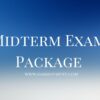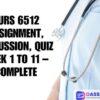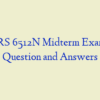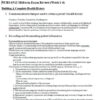Description
NURS 6512N Midterm Exam Week 6 – Advanced Health Assessment
98 out of 100 points
- To perform the Rinne test, place the tuning fork on the:
- You are examining a pregnant patient and have noted a vascular lesion. When you blanche over the vascular lesion, the site blanches and refills evenly from the center outward. The nurse documents this lesion as a:
- When palpating the abdomen, you should note whether the liver is enlarged in the:
- Mr. Kevin Marks is a new health care provider. What is the best method to develop cultural competence?
- The review of systems is a component of the:
- You are planning to palpate the abdomen of your patient. Which part of the examiner’s hand is best for palpating vibration?
- You are completing a general physical examination on Mr. Rock, a 39-year-old man with complaints of constipation. When examining a patient with tense abdominal musculature, a helpful technique is to have the patient:
- Mrs. Britton is a 34-year-old patient who presents to the office with complaints of skin rashes. You have noted a 4′ 3-cm, rough, elevated area of psoriasis. This is an example of a:
- When taking a history, you should:
- In examining the neck of a 34-year-old female patient, you note that the uppermost ridge of the tracheal cartilage is at the:
- When recording physical findings, which data are recorded first for all systems?
- The infant should be placed in which position to have his or her height or length measured?
- During an interview, tears appear in the patient’s eyes and his voice becomes shaky. Initially, you should:
- Which of the following is the most accurate reflection of an individual’s food intake?
- Your patient is complaining of acute, intense sharp epigastric pain that radiates to the back and left scapula with nausea and vomiting. Based on this history, your prioritized physical examination should be to:
- Mr. Williams, age 25, has recovered recently from an upper and lower respiratory infection. He describes a long-standing nasal dripping. He is seeking treatment for a mild hearing loss that has not gone away. Information concerning his chronic postnasal drip should be documented within which section of his history?
- A 51-year-old woman calls with complaints of weight loss and constipation. She reports enlarged hemorrhoids and rectal bleeding. You advise her to:
- A serous membrane that lines the abdominal cavity and forms a protective cover for many abdominal structures is the:
- Which of the following is the most vital nutrient?
- Peritonitis produces bowel sounds that are:
- When are open-ended questions generally most useful?
- Percussing at the right midclavicular line, below the umbilicus, and continuing upward is the correct technique for locating the:
- Mrs. G. reports an increase in her alcohol intake over the past 5 years. To screen her for problem drinking, you would use the:
- During percussion, a dull tone is expected to be heard over:
- The attitudes of the health care professional:
- Spasmodic muscular contractions of the head, face, or neck are called:
- When communicating with older children and teenagers, you should be sensitive to their:
- Ms. Davis is a 27-year-old patient with a BMI of 33. Based on her BMI, your diagnosis would be:
- In counseling a client regarding nutrition education, you explain that linoleic acid, a major fatty acid, is thought to be essential for:
- Recommended carbohydrate content of total dietary intake (% total calories) is ____%.
- The adult recommended dietary fat intake should be _____ g/day.
- Peritonitis produces bowel sounds that are:
- Tracheal tug suggests the presence of a(n):
- When hearing is evaluated, which cranial nerve is being tested?
- Mrs. Raymonds is a 24-year-old patient who has presented for a routine concern over her current weight. In your patient teaching with her, you explain the importance of macronutrients. Which of the following is a macronutrient?
- Mr. Franklin is speaking with you, the health care provider, about his respiratory problem. Mr. Franklin says, “I’ve had this cough for 3 days, and it’s getting worse.” You reply, “Tell me more about your cough.” Mr. Franklin states, “I wish I could tell you more. That’s why I’m here. You tell me what’s wrong!” Which caregiver response would be most appropriate for enhancing communication?
- Which technique is most likely to result in the patient’s understanding of questions?
- Sweat glands, hair, and nails are all formed from:
- During physical examination of a 30-year-old Chinese man, you notice slight asymmetry of his face. The cranial nerve examination is normal. Your best action is to:
- The position on a clock, topographic notations, and anatomic landmarks:
- Expected hair distribution changes in older adults include: (NURS 6512N midterm)
- Your patient is complaining of acute, intense sharp epigastric pain that radiates to the back and left scapula with nausea and vomiting. Based on this history, your prioritized physical examination should be to:
- A fixed image of any group that rejects its potential for originality or individuality is known as a(n):
- Nasal symptoms that imply an allergic response include:
- As you explain your patient’s condition to her husband, you notice that he is leaning toward you and pointedly blinking his eyes. Knowing that he is from England, your most appropriate response to this behavior is to:
- Periods of silence during the interview can serve important purposes, such as:
- Mr. Donalds is a 45-year-old roofer. Your inspection to determine color variations of the skin is best conducted:
- Mr. L. presents to the clinic with severe groin pain and a history of kidney stones. Mr. L.’s son tells you that, for religious reasons, his father wishes to keep any stone that is passed into the urine filter that he has been using. What is your most appropriate response?
- Tangential lighting is best used for inspecting skin:
- Ms. G. is being seen for her routine physical examination. She is a college graduate and president of a research firm. Although her exact salary is unknown, she has adequate health insurance. Most of the above information is part of Ms. G.’s _____ history.
- Coarse, dry, and brittle hair is associated with which metabolic disorder?
- What finding is unique to the documentation of a physical examination of an infant?
- A 17-year-old girl presents to the clinic for a sports physical. Physical examination findings reveal bradycardia, multiple erosions of tooth enamel, and scars on her knuckles. She appears healthy otherwise. You should ask her if she: (NURS 6512N midterm)
- Mr. Black is a 44-year-old patient who presents to the clinic with complaints of neck pain that he thinks is from his job involving computer data entry. As the examiner, you are checking the range of motion in his neck and note the greatest degree of cervical mobility is at:
- Bulging of an amber tympanic membrane without mobility is most often associated with:
- Mrs. Webb is a 38-year-old patient who has been changing her lifestyle to eat in a healthy way and lose weight. During your health promotion education regarding her nutritional status, you explain the function of dietary protein as:
- Mr. D. complains of a headache. During the history, he mentions his use of alcohol and illicit drugs. This information would most likely belong in the:
- Underestimation of blood pressure will occur if the blood pressure cuff’s width covers:
- Which of the following formats would be used for visits that address problems not yet identified in the problem-oriented medical record (POMR)?
- Differential diagnoses belong in the:
- Which statement is true regarding the relationship of physical characteristics and culture?
- Which cranial nerves innervate the face?
- In issues surrounding ethical decision making, beneficence refers to the:
- Small, minute bruises are called:
- The recommended minimum daily protein requirement for the normal adult is ______.
- When you are questioning a patient regarding alcohol intake, she tells you that she is only a social drinker. Which initial response is appropriate?
- A brief statement of the reason the patient is seeking health care is called the:
- You are using an ophthalmoscope to examine a patient’s inner eye. You rotate the lens selector clockwise, then counterclockwise to compensate for: (NURS 6512N midterm)
- Which of the following organs is part of the alimentary tract?
- Mr. Walters, a 32-year-old patient, tells you that his ears are “stopped up.” An objective assessment of this complaint is achieved by using the:
- A 5-year-old child presents with nasal congestion and a headache. To assess for sinus tenderness you should palpate over the:
- Which is the best way to position a patient’s neck for palpation of the thyroid?
- Regardless of the origin, discharge is described by noting:
- During an interview, you have the impression that a patient may be considering suicide. Which action is essential?
- The term denoting the caregiver’s need to do no harm to the patient is:
- To approximate vocal frequencies, which tuning fork should be used to assess hearing?
- Mr. Sanchez is a 45-year-old gentleman who has presented to the office for a physical examination to establish a new primary care health care provider. Which of the following describes a physical, not a cultural, differentiator?
- Mr. Abdul is a 40-year-old Middle Eastern man who presents to the office for a first visit with the complaint of new abdominal pain. You are concerned about violating a cultural prohibition when you prepare to do his rectal examination. The best tactic would be to:
- Inspection of the abdomen should begin with the patient supine and the examiner:
- A tool used to screen adolescents for alcoholism is the:
- Before performing an abdominal examination, the examiner should:
- Which of the following is an expected change in the assessment of the thyroid during pregnancy?
- Mrs. Hartzell is a 34-year-old patient who has presented for nutritional counseling because she is a vegetarian. Deficiency of which of the following is a concern in the vegetarian diet? (NURS 6512N midterm)
- A guideline for history taking is for caregivers to:
- When assessing abdominal pain in a college-age woman, one must include:
- Which question would be considered a leading question?
- Mr. and Mrs. Johnson have presented to the office with their infant son with complaints of ear drainage. When examining an infant’s middle ear, the nurse should use one hand to stabilize the otoscope against the head while using the other hand to:
- Placing the base of a vibrating tuning fork on the midline vertex of the patient’s head is a test for:
- The examiner’s evaluation of a patient’s mental status belongs in the:
- Mrs. Kinder is a 39-year-old patient who presents to the office with complaints of an earache. In explaining to the patient about the function of her ears, which ear structure would you tell her is responsible for equalizing atmospheric pressure when swallowing, sneezing, or yawning?
- Mrs. Leonard brings her newborn infant into the pediatrician’s office for a first well-baby visit. As the health care provider, you teach her that newborns are more vulnerable to hypothermia due to:
- Expected normal percussion tones include:
- The most common form of birth trauma of the scalp is:
- Your patient presents with symptoms that lead you to suspect acute appendicitis. Which assessment finding is least likely to be associated with this condition early in its course?
- Under normal circumstances, how much water is lost daily by the body?
- As part of your health promotion education for a new patient, you explain that the risk factors for skin cancer include:
- To correctly document absent bowel sounds, one must listen continuously for:
- Which of the following is an “ABCD” characteristic of malignant melanoma? (NURS 6512N midterm)
- Mr. Jones is a 45-year-old patient who presents for a physical examination. On examination, you note costochondral beading, enlarged skull, and bowed legs and diagnose him with rickets. A deficiency of which fat-soluble micronutrient can result in rickets?
- Tympanic thermometers measure body temperature when a probe is placed






